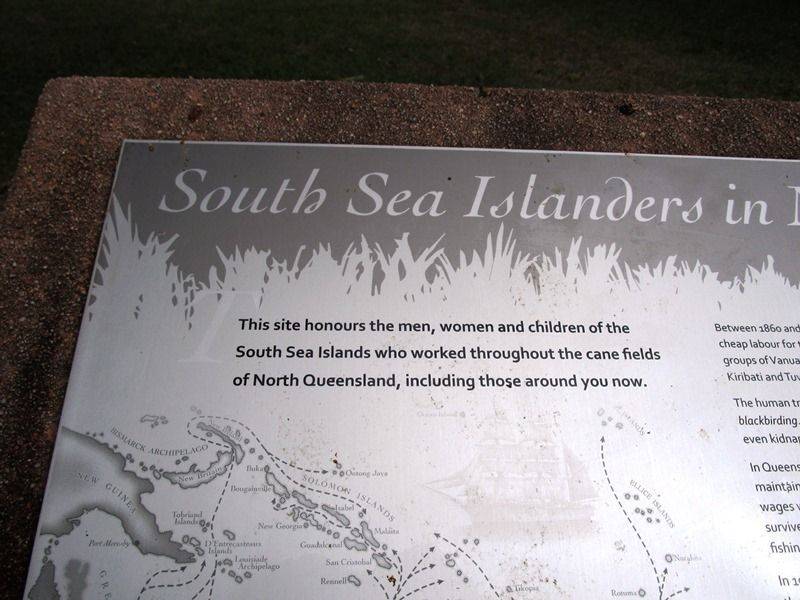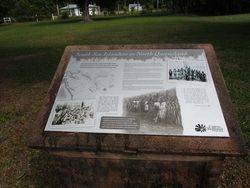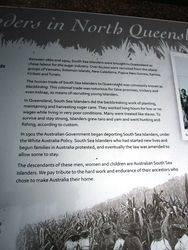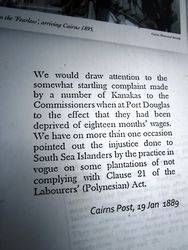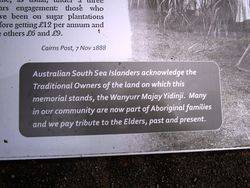
Home » Themes » Culture » Indigenous
South Sea Islander MemorialPrint Page 
The monument commemorates South Sea Islanders who worked the cane fields of North Queensland. South Sea Islanders were bought to Queensland as labour to work in cotton and cane fields.
Islanders were used as conscript labour in Queensland`s sugar cane industry from 1863 to 1906. Over forty ships brought the Islanders to Queensland, many of whom were kidnapped or `blackbirded`, having little understanding of the three year labour contracts they had signed. Twelve thousand "kanakas" as they were called, were brought into the area around Hervey Bay, initially by one Captain Coath.
The Captain`s methods caused the death of many Islanders during the voyage to Australia. A government agent, Meiklejohn, was sent to check that the recruiting was fair. During this trip, the Captain put the agent in chains where he stayed for the remainder of the voyage. As a result, Meiklejohn temporarily lost his sanity but when he recovered his testimony led to Coath`s imprisonment.
Location
| Address: | Bruce Highway & McMahon Drive, Fishery Falls, 4871 |
|---|---|
| State: | QLD |
| Area: | AUS |
| GPS Coordinates: | Lat: -17.185171 Long: 145.887581 Note: GPS Coordinates are approximate. |
Details
| Monument Type: | Monument |
|---|---|
| Monument Theme: | Culture |
| Sub-Theme: | Indigenous |
| Approx. Event Start Date: | 1860 |
| Approx. Event End Date: | 1904 |
Dedication
South Sea Islanders in North Queensland
This site honours the men, women and children of the South Sea Islands, who worked throughout the cane fields of North Queensland, including those around you now.
Between 1860 and 1904, South Sea Islanders were brought to Queensland as cheap labour for the sugar industry. Ove 60,000 were recruited from the island groups of Vanuatu, Solomon Islands, New Caledonia, Papua New Guinea, Samoa, Kiribati and Tuvalu.
The human trade of South Sea Islanders to Queensland was commonly known as blackbirding. This colonial trade was notorious for false promises, trickery and even kidnap, as means of recruiting young islanders.
In Queensland, South Sea Islanders did the backbreaking work of planting, maintaining and harvesting sugar cane. They worked long hours for low or no wages while living in very poor conditions. Many were treated like slaves. To survive and stay strong, Islanders grew taro and yam and went hunting and fishing, according to custom.
In 1901 the Australian Government began deporting South Sea Islanders, under the White Australia Policy. South Sea Islanders who had started new lives and begun families in Australia protested, and eventually the law was amended to allow some to stay.
The descendants of these men, women and children are Australian South Sea Islanders. We pay tribute to the hard work and endurance of their ancestors who chose to make Australia their home.
We would draw attention to the somewhat startling complaint made by a number of Kanakas to the Commissioners when at Port Douglas to the effect that they had been deprived of eighteen months` wages. We have on more than one occassion pointed out the injustice done to South Sea Islanders by the practice in vogue on some plantations of not complying with Clause 21 of the Labourers` (Polynesian) Act. Cairns Post, 19 Jan 1889.
Australian South Sea Islanders acknowledge the traditional owners of the land on which this memorial stands, the Wanyurr Majay Yidinji. Many in our community are now part of Aboriginal families and we pay tribute to the Elders, past and present.


